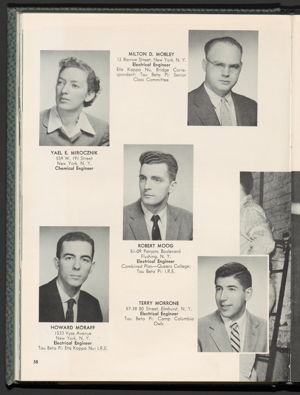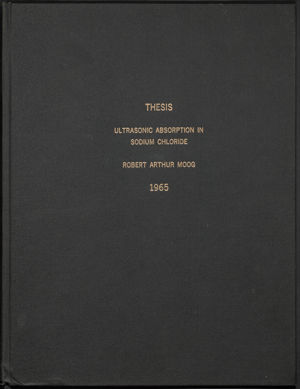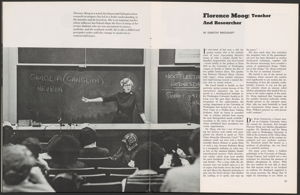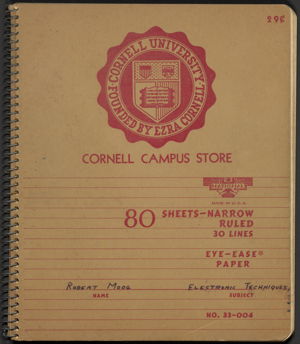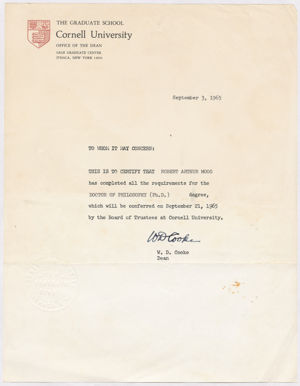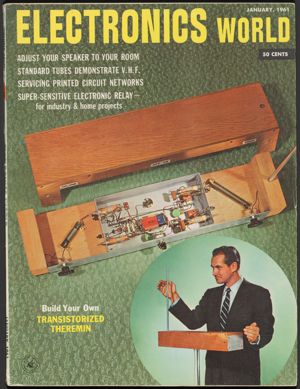From Columbia to Cornell
Columbia University. The Columbia Engineer Yearbook, 1957. (1 image)
Bob’s training in electrical engineering at Columbia supplemented his hobbyist background in preparing him for a future career as an inventor. His father worked for Con Edison and had a basement workshop in Flushing, Queens, New York City, where Bob learned to build electronic gear. Bob’s undergraduate transcripts from Columbia University for 1956-57 depict him as an erratic student. While he earned many As and Bs, he achieved only a D in Mechanical Engineering and a C in an Electrical Engineering course!
Bob’s training in electrical engineering at Columbia supplemented his hobbyist background in preparing him for a future career as an inventor. His father worked for Con Edison and had a basement workshop in Flushing, Queens, New York City, where Bob learned to build electronic gear. Bob’s undergraduate transcripts from Columbia University for 1956-57 depict him as an erratic student. While he earned many As and Bs, he achieved only a D in Mechanical Engineering and a C in an Electrical Engineering course!
While at Columbia, Bob visited the famous Columbia-Princeton Electronic Music studio where the RCA Mark II electronic music synthesizer was housed. This was more like an analog computer—a gigantic room full of tubes controlled by punch hole tape. Bob used to hang out at Radio Row in New York City (later demolished to make way for the World Trade Center), where the full range of hobbyist gear could be bought and sold.
Robert Moog. Doctoral thesis. “Ultrasonic Absorption in Sodium Chloride,” 1965. (1 image)
Bob earned his PhD at Cornell University in Engineering Physics. The topic of his dissertation, “Ultrasonic Absorption in Sodium Chloride,” had little to do with his growing interest in building electronic music synthesizers. As Bob struggled to finish his thesis on time, he was preparing the electronics for the world premiere of John Cage’s Variations V.
Bob earned his PhD at Cornell University in Engineering Physics. The topic of his dissertation, “Ultrasonic Absorption in Sodium Chloride,” had little to do with his growing interest in building electronic music synthesizers. As Bob struggled to finish his thesis on time, he was preparing the electronics for the world premiere of John Cage’s Variations V.
Dorothy Brockhoff. “Florence Moog: Teacher and Researcher.” Washington University Magazine, Spring 1974. (1 image)
Bob’s aunt, Florence E. Moog (1915-86), was an influential figure in his life as well as a renowned developmental biologist at Washington University in St. Louis, MO. The two maintained a regular and lively correspondence. In this letter to his aunt, Bob comments on life as a graduate student at Cornell. Not much seems to have changed: he complains that air travel from Ithaca to New York City is unreliable and unaffordable.
Bob’s aunt, Florence E. Moog (1915-86), was an influential figure in his life as well as a renowned developmental biologist at Washington University in St. Louis, MO. The two maintained a regular and lively correspondence. In this letter to his aunt, Bob comments on life as a graduate student at Cornell. Not much seems to have changed: he complains that air travel from Ithaca to New York City is unreliable and unaffordable.
Robert Moog. Cornell University student notebook. “Electronic Techniques.” Ca. 1960. (1 image)
This Cornell notebook contains extensive notes and hand drawings prepared as part of Bob’s course work.
This Cornell notebook contains extensive notes and hand drawings prepared as part of Bob’s course work.
Cornell University. Typed Letter to Robert Moog. Sept. 3, 1965. (1 image)
This September 1965 letter from the University affirms that Bob had met all the requirements for his PhD.
This September 1965 letter from the University affirms that Bob had met all the requirements for his PhD.
Robert A. Moog. “A Transistorized Theremin” In: Electronics World, January 1961. (1 image)
While studying for his PhD at Cornell, Bob kept up his hobbyist business building Theremins. A transistorized Theremin of his design was featured in the hobbyist magazine Electronics World in 1961.
While studying for his PhD at Cornell, Bob kept up his hobbyist business building Theremins. A transistorized Theremin of his design was featured in the hobbyist magazine Electronics World in 1961.
